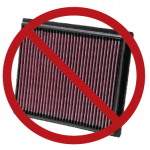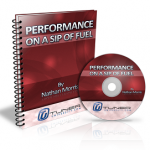I've been saying it for years, but "drop-in" air filters such as those marketed by multiple major names are unfortunately, mostly a sham.
I have yet to see a single vehicle where when I measured pressure drop across the filter that a drop-in filter made a measurable improvement. Pressure drop by the way is NOT a measurement of flow, but rather an indirect measurement of flow (by measuring how much air pressure has been lost from one point in a pipe system to another), one which especially in the case of filters is more accurate than a flow bench.
We've already talked about the poor filtering of these "aftermarket high flow filters" here, but let's explore flow again.
Anyhow, I came across a great article written by Mance Etheredge. I tried to find a way to contact him to give him props for his work but I'll have to settle for a shout out here.
Mance measured the air flow (on a flow bench rather than my more DIY method) of several drop-in air filters for a 12v Audi. I recommend you read his article to see the full low-down on the "high flow" filter vs the factory vs the factory replacements.
http://12v.org/audi/afcompare/
Note that the tested K&N flowed nearly the same as the factory Audi filter, but all the other "cheapo" filters flowed worse to significantly worse. The Purolator "oem replacement" filter in the test actually flowed 110cfm LESS than the factory filter, all the rest of them were worse than factory. I -have- seen instances where cheapo air filters created more pressure drop than factory (and ironically, many "aftermarket performance" filters too).
Bear in mind these numbers are pure "flow"... nothing more, nothing less. They don't address or speak to any pressure differentials once mounted in the airbox.
So yep, even though the K&N's *slight* itty bitty flow ("4" cfm - almost within the margin of error) increase seems to suggest there might be something there, as seen in my own hands-on testing - there isn't. I can assure you that other brands are the same, and often worse. K&N is actually the better one of the group since the closest aftermarket "oem replacement" filter is a full 50cfm lower than the actual OEM filter.
Nothing wrong with K&N as a company, and while yes they are fine reusable filters, you won't find an easy "drop-in" horsepower gain with them. OEM filters are usually very inexpensive and they're of known quality.

Is the horse dead yet?
Better to focus on ways to reduce pressure drop in other places in the system than with a filter replacement regardless of the brand or product claims. For example, by fitting a different snorkel or smoothing out the intake arm for example.
See my article on "Intelligent Modification" for more information on pressure drop and how to go about those kinds of more meaningful modifications.
Extremely Limited Time Offer - 3 Days Only
Get a MASTERS DEGREE in Performance Tuning from the BEST in the Field for ONE low package price
For 3 days only, get ALL of our PREMIUM (not available anywhere else) Tuner University Courses featuring some of the greatest minds in motorsports:
- Top 10 Performance Myths Class (MP3 and Edited Transcript) - $29.95 value
- Performance on a Sip of Fuel Class (MP3 and class manual) - $69.95 value
- Header Design Secrets with John Grudynski (MP3 and transcript) - $69.95 value
- Dirty Secrets of Oil with Ryan Stark (MP3 and transcript) - $69.95 value
- Engine Tuning Secrets with Ben Strader of EFI University (MP3 and Transcript) - $69.95 value
Get all of the above courses (many of which not currently available anywhere else) for one single price of just $309.75 $69.95. A HUGE package savings.
You can also buy any of these individually through our resource center, but I don't know why you would as this is basically the whole store for the price of just 1 course. You'll get the MP3 recordings of each class as well as a transcript or companion manual with each course and you'll be able to download them all INSTANTLY.






